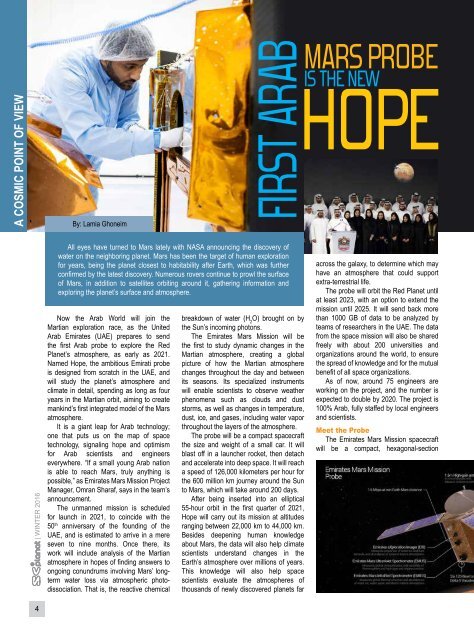ARABS
7eM8kM
7eM8kM
Create successful ePaper yourself
Turn your PDF publications into a flip-book with our unique Google optimized e-Paper software.
A COSMIC POINT OF VIEW<br />
By: Lamia Ghoneim<br />
FIRST ARAB<br />
MARS PROBE<br />
IS THE NEW<br />
HOPE<br />
| WINTER 2016<br />
All eyes have turned to Mars lately with NASA announcing the discovery of<br />
water on the neighboring planet. Mars has been the target of human exploration<br />
for years, being the planet closest to habitability after Earth, which was further<br />
confirmed by the latest discovery. Numerous rovers continue to prowl the surface<br />
of Mars, in addition to satellites orbiting around it, gathering information and<br />
exploring the planet’s surface and atmosphere.<br />
Now the Arab World will join the<br />
Martian exploration race, as the United<br />
Arab Emirates (UAE) prepares to send<br />
the first Arab probe to explore the Red<br />
Planet’s atmosphere, as early as 2021.<br />
Named Hope, the ambitious Emirati probe<br />
is designed from scratch in the UAE, and<br />
will study the planet’s atmosphere and<br />
climate in detail, spending as long as four<br />
years in the Martian orbit, aiming to create<br />
mankind’s first integrated model of the Mars<br />
atmosphere.<br />
It is a giant leap for Arab technology;<br />
one that puts us on the map of space<br />
technology, signaling hope and optimism<br />
for Arab scientists and engineers<br />
everywhere. “If a small young Arab nation<br />
is able to reach Mars, truly anything is<br />
possible,” as Emirates Mars Mission Project<br />
Manager, Omran Sharaf, says in the team’s<br />
announcement.<br />
The unmanned mission is scheduled<br />
for launch in 2021, to coincide with the<br />
50 th anniversary of the founding of the<br />
UAE, and is estimated to arrive in a mere<br />
seven to nine months. Once there, its<br />
work will include analysis of the Martian<br />
atmosphere in hopes of finding answers to<br />
ongoing conundrums involving Mars’ longterm<br />
water loss via atmospheric photodissociation.<br />
That is, the reactive chemical<br />
breakdown of water (H 2<br />
O) brought on by<br />
the Sun’s incoming photons.<br />
The Emirates Mars Mission will be<br />
the first to study dynamic changes in the<br />
Martian atmosphere, creating a global<br />
picture of how the Martian atmosphere<br />
changes throughout the day and between<br />
its seasons. Its specialized instruments<br />
will enable scientists to observe weather<br />
phenomena such as clouds and dust<br />
storms, as well as changes in temperature,<br />
dust, ice, and gases, including water vapor<br />
throughout the layers of the atmosphere.<br />
The probe will be a compact spacecraft<br />
the size and weight of a small car. It will<br />
blast off in a launcher rocket, then detach<br />
and accelerate into deep space. It will reach<br />
a speed of 126,000 kilometers per hour for<br />
the 600 million km journey around the Sun<br />
to Mars, which will take around 200 days.<br />
After being inserted into an elliptical<br />
55-hour orbit in the first quarter of 2021,<br />
Hope will carry out its mission at altitudes<br />
ranging between 22,000 km to 44,000 km.<br />
Besides deepening human knowledge<br />
about Mars, the data will also help climate<br />
scientists understand changes in the<br />
Earth’s atmosphere over millions of years.<br />
This knowledge will also help space<br />
scientists evaluate the atmospheres of<br />
thousands of newly discovered planets far<br />
across the galaxy, to determine which may<br />
have an atmosphere that could support<br />
extra-terrestrial life.<br />
The probe will orbit the Red Planet until<br />
at least 2023, with an option to extend the<br />
mission until 2025. It will send back more<br />
than 1000 GB of data to be analyzed by<br />
teams of researchers in the UAE. The data<br />
from the space mission will also be shared<br />
freely with about 200 universities and<br />
organizations around the world, to ensure<br />
the spread of knowledge and for the mutual<br />
benefit of all space organizations.<br />
As of now, around 75 engineers are<br />
working on the project, and the number is<br />
expected to double by 2020. The project is<br />
100% Arab, fully staffed by local engineers<br />
and scientists.<br />
Meet the Probe<br />
The Emirates Mars Mission spacecraft<br />
will be a compact, hexagonal-section<br />
4


